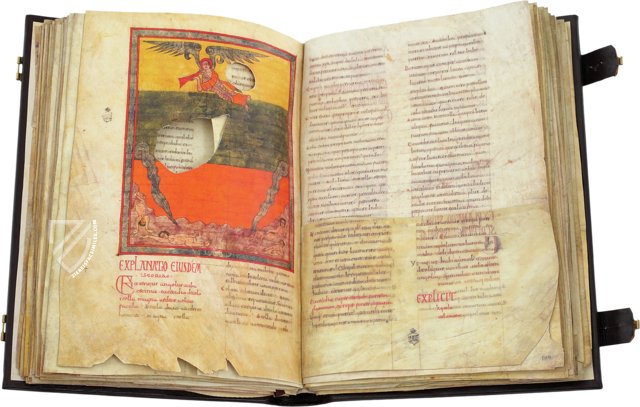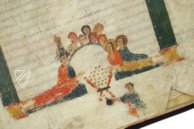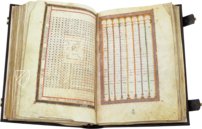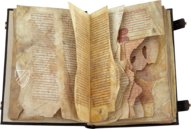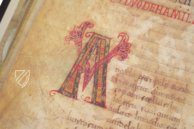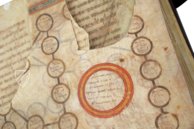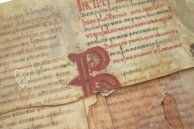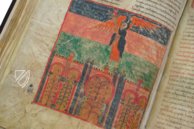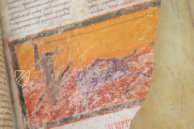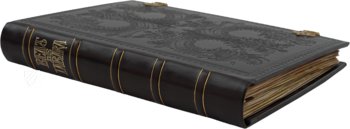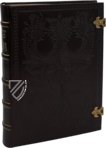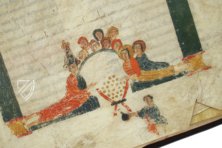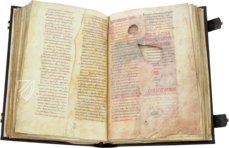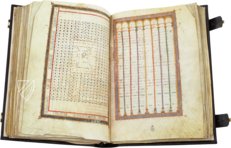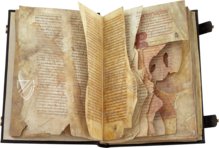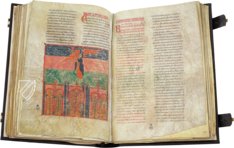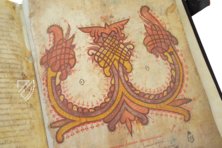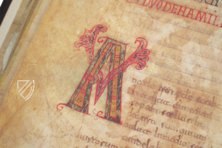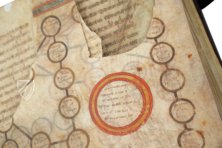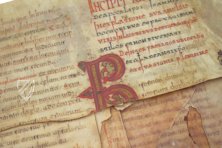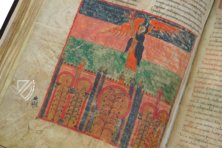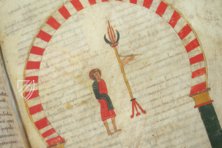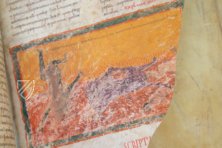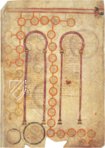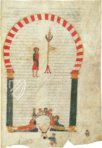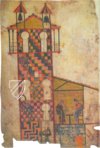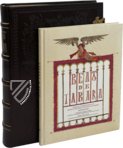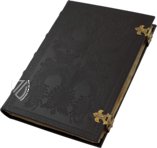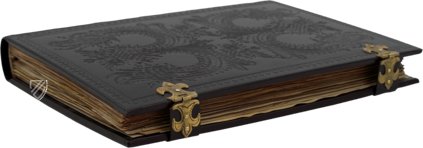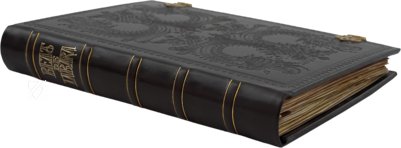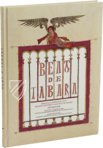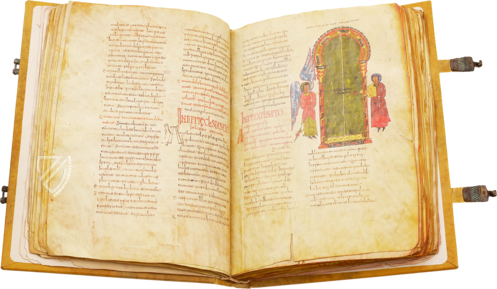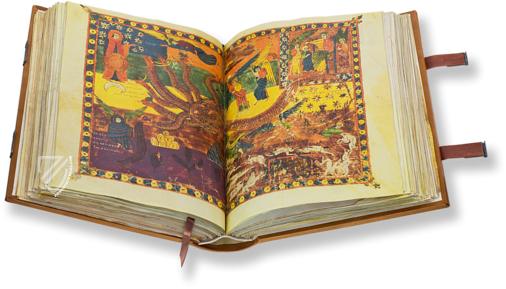Beatus of Liébana - Tábara Codex
(3,000€ - 7,000€)
The famous depiction of the scriptorium in the tower makes the Tábara Codex a unique specimen of the northern Spanish Beatus tradition. Yet the manuscript, dated the 27th of July, 970, rests on other laurels, e.g. with the naming of the famous miniaturist Maius and his pupil Emeterius. The famous scriptorium of San Salvador de Tábara produced a true masterpiece with this Beatus codex, which in turn served as a template for other magnificent manuscripts. Today the Tábara Codex is stored in the Spanish National Archive in Madrid.
Beatus of Liébana - Tábara Codex
The famous depiction of the scriptorium in the tower makes the Tábara Codex a unique specimen of the northern Spanish Beatus tradition. Yet the manuscript, dated the 27th of July, 970, rests on other laurels, e.g. with the naming of the famous miniaturist Maius and his pupil Emeterius. The famous scriptorium of San Salvador de Tábara produced a true masterpiece with this Beatus codex, which in turn served as a template for other magnificent manuscripts. Today the Tábara Codex is stored in the Spanish National Archive in Madrid.
A Plundered Treasure
The Beatus manuscripts of the 10th–12th centuries altogether comprise great highpoints of northern Spanish illumination. Yet there are a few specimens that distinguish themselves through their particular characteristics or outstanding quality. Most certainly belonging among these is the Tábara Codex. The 366 pages of the codex are unfortunately only adorned with eight miniatures. Yet this fact – the remaining pictures were cut out and probably stored separately – indicates the high esteem that the artistic furnishings of the manuscript enjoyed in earlier centuries. The original splendor of the pictorial content of the famous Tábara Codex can still be comprehended in spite of everything because the Beatus of Los Huelgas (found today in the Pierpont Morgan Library in New York) was copied from the Tábara Codex ca. 1220.
The Famous Tower Scriptorium
A particularly well-known and groundbreaking miniature is nonetheless still contained in the codex: the famous miniature with the depiction of the monastery’s tower, in which the famous scriptorium was found. This depiction of the famous tower scriptorium of Tábara is simultaneously the oldest and sui generis of its type in European art. The monastery of San Salvador de Tábara in León was a center of book production of great and important proportions in the 10th and 11th centuries. It was in this very scriptorium that the Tábara Codex was finished in the year 970, which can be understood by the dating of the manuscript to the 27th of July, 970.
The Master Maius and his Pupil
A famous monk and miniaturist from the scriptorium of Tábara was responsible for the artistic furnishing of the codex. In the manuscript, a certain Emeterius records the death of his teacher Maius on the 30th of October, 968. This Maius is generally believed to be the Maius, the famous miniaturist. Alongside Maius and Emeterius, who continued the work of his teacher, the names of two other scribes, Monnius and Senior, are mentioned. These detailed notes in the manuscript make the Tábara Codex something truly special. Furthermore, the text contains marginal notes in Arabic. This can be an indication of the manuscript’s use in a “Mozarabic” context, so from a Christian of Andalusian origin, and represents a further special feature. As a result, the Tábara Codex, which is housed today in the Spanish National Archives in Madrid, is an exceptional piece of art history and an important witness to the great Beatus tradition of northern Spain!
Codicology
- Alternative Titles
- Beatus von Liébana - Codex von Tábara
Beato de Tábara
Tabara Beatus - Size / Format
- 366 pages / 36.0 × 25.5 cm
- Origin
- Spain
- Date
- 10th century
- Epochs
- Style
- Genre
- Illustrations
- 8 illustrations
- Artist / School
- Beatus of Liébana (died after 798) (author)
Magius and Emeterius (illuminators)
Monniu presbiter (scribe)
León School - Previous Owners
- Ramón Alvarez de la Braña
Diplomatic School of Spain
Beatus of Liébana - Tábara Codex
Omega
“I am the Alpha and the Omega, the Beginning and the End,” says the Lord, “who is and who was and who is to come, the Almighty.” (Rev. 1:8). Created with delicate shades of pink and purple, bright red, and golden yellow, this elaborate initial appears above a colophon in the text. It explains that work on the manuscript was begun by Master Magius, but he died before finishing it and the work was carried on by his disciple Emeterio and a nun named Eude, who completed it on July 27th, 970.
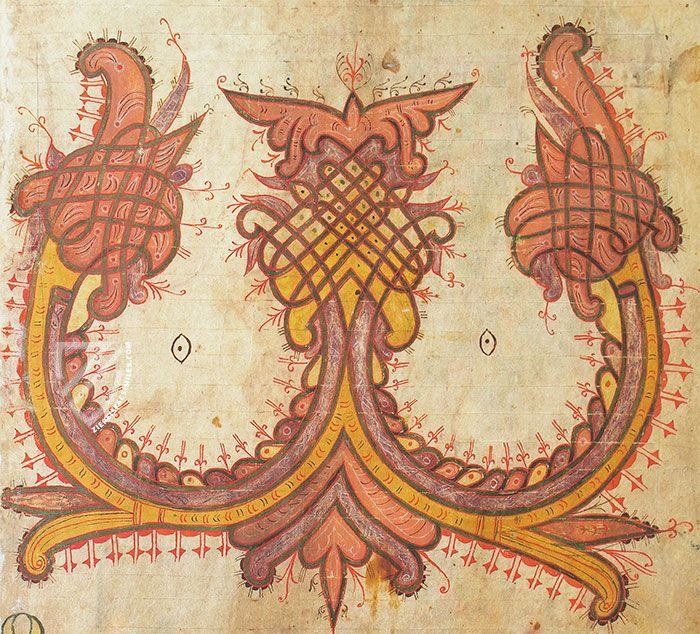
Beatus of Liébana - Tábara Codex
Tower Scriptorium of the Tábara monastery
The tower scriptorium of the San Salvador de Tábara Monastery was one of the most important sites for the production of manuscripts during the 10th and 11th centuries. This miniature of the important edifice is the oldest image of a scriptorium found in all of medieval European art and is considered to be one of the most interesting specimens of Mozarabic illumination.
Two scribes, identified in an inscription as Emeterio and Senior, are working together in the scriptorium while in an adjacent room, a third figure is shown cutting parchment with scissors. Three additional figures are shown climbing up ladders to reach the bells at the top of the tower, which is covered in colorful tiles and has horseshoe arches in the Moorish style.
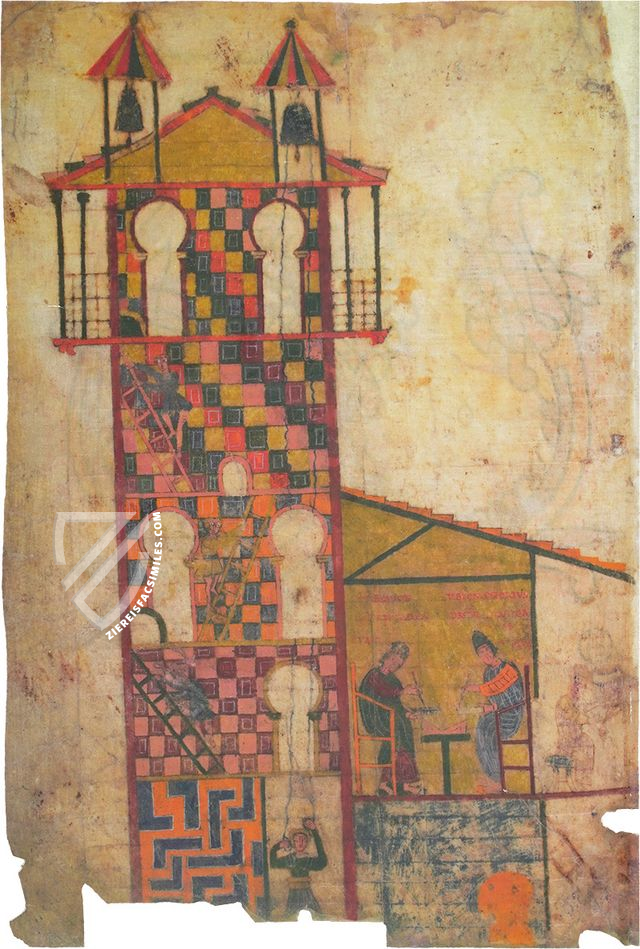
#1 Beato de Tábara
Language: Spanish
(3,000€ - 7,000€)
- Treatises / Secular Books
- Apocalypses / Beatus
- Astronomy / Astrology
- Bestiaries
- Bibles / Gospels
- Chronicles / History / Law
- Geography / Maps
- Saints' Lives
- Islam / Oriental
- Judaism / Hebrew
- Single Leaf Collections
- Leonardo da Vinci
- Literature / Poetry
- Liturgical Manuscripts
- Medicine / Botany / Alchemy
- Music
- Mythology / Prophecies
- Psalters
- Other Religious Books
- Games / Hunting
- Private Devotion Books
- Other Genres
- Afghanistan
- Armenia
- Austria
- Belgium
- Colombia
- Croatia
- Czech Republic
- Denmark
- Egypt
- Ethiopia
- France
- Germany
- Hungary
- India
- Iran
- Iraq
- Israel
- Italy
- Japan
- Luxembourg
- Mexico
- Morocco
- Netherlands
- Peru
- Poland
- Portugal
- Russia
- Serbia
- Spain
- Sri Lanka
- Sweden
- Switzerland
- Syria
- Turkey
- Ukraine
- United Kingdom
- United States
- Uzbekistan
- Aboca Museum
- Ajuntament de Valencia
- Akademie Verlag
- Akademische Druck- u. Verlagsanstalt (ADEVA)
- Aldo Ausilio Editore - Bottega d’Erasmo
- Alecto Historical Editions
- Alkuin Verlag
- Almqvist & Wiksell
- Amilcare Pizzi
- Andreas & Andreas Verlagsbuchhandlung
- Archa 90
- Archiv Verlag
- Archivi Edizioni
- Arnold Verlag
- ARS
- Ars Magna
- ArtCodex
- AyN Ediciones
- Azimuth Editions
- Badenia Verlag
- Bärenreiter-Verlag
- Belser Verlag
- Belser Verlag / WK Wertkontor
- Benziger Verlag
- Bernardinum Wydawnictwo
- BiblioGemma
- Biblioteca Apostolica Vaticana (Vaticanstadt, Vaticanstadt)
- Bibliotheca Palatina Faksimile Verlag
- Bibliotheca Rara
- Boydell & Brewer
- Bramante Edizioni
- Brepols Publishers
- British Library
- C. Weckesser
- Caixa Catalunya
- Canesi
- CAPSA, Ars Scriptoria
- Caratzas Brothers, Publishers
- Carus Verlag
- Circulo Cientifico
- Club Bibliófilo Versol
- Club du Livre
- CM Editores
- Collegium Graphicum
- Collezione Apocrifa Da Vinci
- Comissão Nacional para as Comemorações dos Descobrimentos Portugueses
- Coron Verlag
- Corvina
- CTHS
- D. S. Brewer
- De Agostini/UTET
- De Schutter
- Deuschle & Stemmle
- Deutscher Verlag für Kunstwissenschaft
- DIAMM
- Droz
- E. Schreiber Graphische Kunstanstalten
- Ediciones Boreal
- Ediciones Grial
- Ediclube
- Edições Inapa
- Edilan
- Editalia
- Edition Georg Popp
- Edition Leipzig
- Edition Libri Illustri
- Editiones Reales Sitios S. L.
- Éditions de l'Oiseau Lyre
- Editions Medicina Rara
- Editorial Casariego
- Editorial Mintzoa
- Editrice Antenore
- Editrice Velar
- Edizioni Edison
- Egeria, S.L.
- Eikon Editores
- Electa
- Enciclopèdia Catalana
- Eos-Verlag
- Ephesus Publishing
- Eugrammia Press
- Extraordinary Editions
- Fackelverlag
- Facsimila Art & Edition
- Facsimile Editions Ltd.
- Facsimilia Art & Edition Ebert KG
- Faksimile Verlag
- Feuermann Verlag
- Folger Shakespeare Library
- Franco Cosimo Panini Editore
- Friedrich Wittig Verlag
- Fundación Hullera Vasco-Leonesa
- G. Braziller
- Gabriele Mazzotta Editore
- Gebr. Mann Verlag
- Gesellschaft für graphische Industrie
- Getty Research Institute
- Giovanni Domenico de Rossi
- Giunti Editore
- Graffiti
- Grafica European Center of Fine Arts
- Guido Pressler
- Guillermo Blazquez
- H. N. Abrams
- Harrassowitz
- Helikon
- Hendrickson Publishers
- Henning Oppermann
- Herder Verlag
- Hes & De Graaf Publishers
- Hoepli
- Hortus Deliciarum
- Houghton Library
- Hugo Schmidt Verlag
- Idion Verlag
- Il Bulino, edizioni d'arte
- ILte
- Imago
- Insel Verlag
- Instituto de Estudios Altoaragoneses
- Instituto Nacional de Antropología e Historia
- Istituto dell'Enciclopedia Italiana - Treccani
- Istituto Ellenico di Studi Bizantini e Postbizantini
- Istituto Geografico De Agostini
- Istituto Poligrafico e Zecca dello Stato
- Italarte Art Establishments
- J. Thorbecke
- Jan Thorbecke Verlag
- Johnson Reprint Corporation
- Jugoslavija
- Karl W. Hiersemann
- Kasper Straube
- Kaydeda Ediciones
- Konrad Kölbl Verlag
- Kurt Wolff Verlag
- La Liberia dello Stato
- La Linea Editrice
- La Meta Editore
- Lambert Schneider
- Landeskreditbank Baden-Württemberg
- Leo S. Olschki
- Les Incunables
- Library of Congress
- Libreria Musicale Italiana
- Lichtdruck
- Lito Immagine Editore
- Lumen Artis
- Lund Humphries
- M. Moleiro Editor
- Maison des Sciences de l'homme et de la société de Poitiers
- Manuscriptum
- Maruzen-Yushodo Co. Ltd.
- MASA
- McGraw-Hill
- Militos
- Millennium Liber
- Müller & Schindler
- National Library of Wales
- Neri Pozza
- Nova Charta
- Oceanum Verlag
- Odeon
- Orbis Mediaevalis
- Orbis Pictus
- Österreichische Staatsdruckerei
- Oxford University Press
- Pageant Books
- Parzellers Buchverlag
- Patrimonio Ediciones
- Pattloch Verlag
- PIAF
- Pieper Verlag
- Plon-Nourrit et cie
- Prestel Verlag
- Princeton University Press
- Prisma Verlag
- Priuli & Verlucca, editori
- Pro Sport Verlag
- Propyläen Verlag
- Pytheas Books
- Quaternio Verlag Luzern
- Reales Sitios
- Recht-Verlag
- Reichert Verlag
- Reichsdruckerei
- Riehn & Reusch
- Roberto Vattori Editore
- Rosenkilde and Bagger
- Roxburghe Club
- Salerno Editrice
- Sarajevo Svjetlost
- Schöck ArtPrint Kft.
- Scolar Press
- Scrinium
- Scripta Maneant
- Scriptorium
- Siloé, arte y bibliofilia
- SISMEL - Edizioni del Galluzzo
- Sociedad Mexicana de Antropología
- Sorli Ediciones
- Stainer and Bell
- Styria Verlag
- Sumptibus Pragopress
- Szegedi Tudomànyegyetem
- Taberna Libraria
- Tarshish Books
- Taschen
- Tempus Libri
- Testimonio Compañía Editorial
- Thames and Hudson
- The Clear Vue Publishing Partnership Limited
- The Facsimile Codex
- The Folio Society
- The Marquess of Normanby
- The Richard III and Yorkist History Trust
- Tip.Le.Co
- TouchArt
- TREC Publishing House
- TRI Publishing Co.
- Trident Editore
- Typis Regiae Officinae Polygraphicae
- Universidad de Granada
- University of California Press
- University of Chicago Press
- Urs Graf
- Vallecchi
- Van Wijnen
- VCH, Acta Humaniora
- VDI Verlag
- Verlag für Regionalgeschichte
- Verlag Styria
- Vicent Garcia Editores
- W. Turnowsky
- Wiener Mechitharisten-Congregation (Wien, Österreich)
- Wissenschaftliche Buchgesellschaft
- Xuntanza Editorial
- Zollikofer AG


